Analysis of ERP Systems and Their Impact on Public Transport
VerifiedAdded on 2020/03/23
|19
|3673
|458
Report
AI Summary
This research report investigates the implementation and benefits of Enterprise Resource Planning (ERP) systems within the public transport sector in Australia. The report begins by outlining key business processes within transport organizations, including mode support, finance, operations, and strategic management. It then details the business and systems requirements for successful ERP integration, emphasizing the need for real-time data updates and user-friendly software. The report explores software and vendor selection, highlighting major players like SAP and Oracle, and discusses ways to utilize technology for business efficiency, such as integrated information and process automation. It also addresses potential security risks associated with ERP systems, including outdated software and data breaches, and proposes mitigation strategies to protect confidential information. The report concludes by emphasizing the transformative impact of ERP systems on public transport, offering valuable insights for industry professionals and students alike.

Paraphrase This Document
Need a fresh take? Get an instant paraphrase of this document with our AI Paraphraser
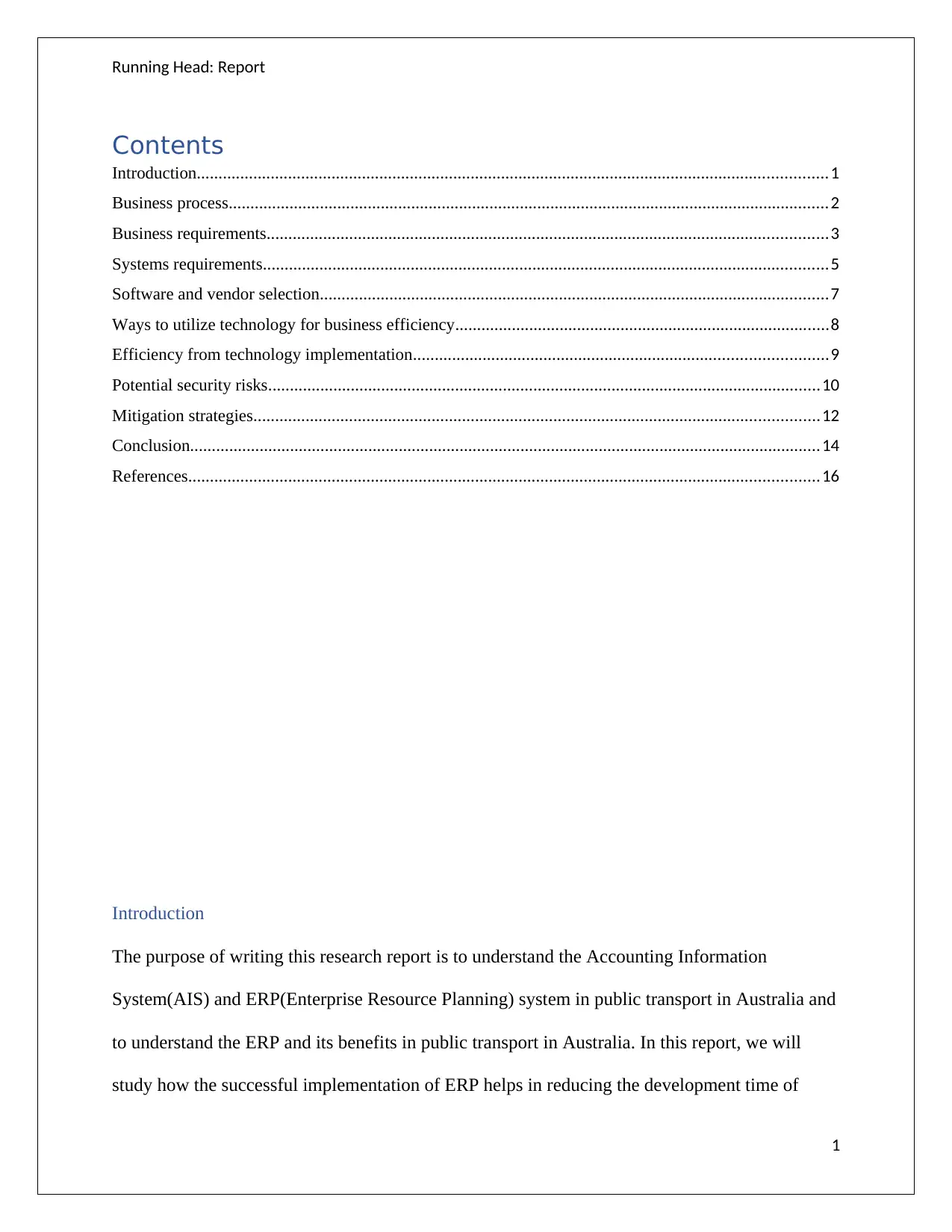
Running Head: Report
Contents
Introduction.................................................................................................................................................1
Business process..........................................................................................................................................2
Business requirements.................................................................................................................................3
Systems requirements..................................................................................................................................5
Software and vendor selection.....................................................................................................................7
Ways to utilize technology for business efficiency......................................................................................8
Efficiency from technology implementation...............................................................................................9
Potential security risks...............................................................................................................................10
Mitigation strategies..................................................................................................................................12
Conclusion.................................................................................................................................................14
References.................................................................................................................................................16
Introduction
The purpose of writing this research report is to understand the Accounting Information
System(AIS) and ERP(Enterprise Resource Planning) system in public transport in Australia and
to understand the ERP and its benefits in public transport in Australia. In this report, we will
study how the successful implementation of ERP helps in reducing the development time of
1
Contents
Introduction.................................................................................................................................................1
Business process..........................................................................................................................................2
Business requirements.................................................................................................................................3
Systems requirements..................................................................................................................................5
Software and vendor selection.....................................................................................................................7
Ways to utilize technology for business efficiency......................................................................................8
Efficiency from technology implementation...............................................................................................9
Potential security risks...............................................................................................................................10
Mitigation strategies..................................................................................................................................12
Conclusion.................................................................................................................................................14
References.................................................................................................................................................16
Introduction
The purpose of writing this research report is to understand the Accounting Information
System(AIS) and ERP(Enterprise Resource Planning) system in public transport in Australia and
to understand the ERP and its benefits in public transport in Australia. In this report, we will
study how the successful implementation of ERP helps in reducing the development time of
1
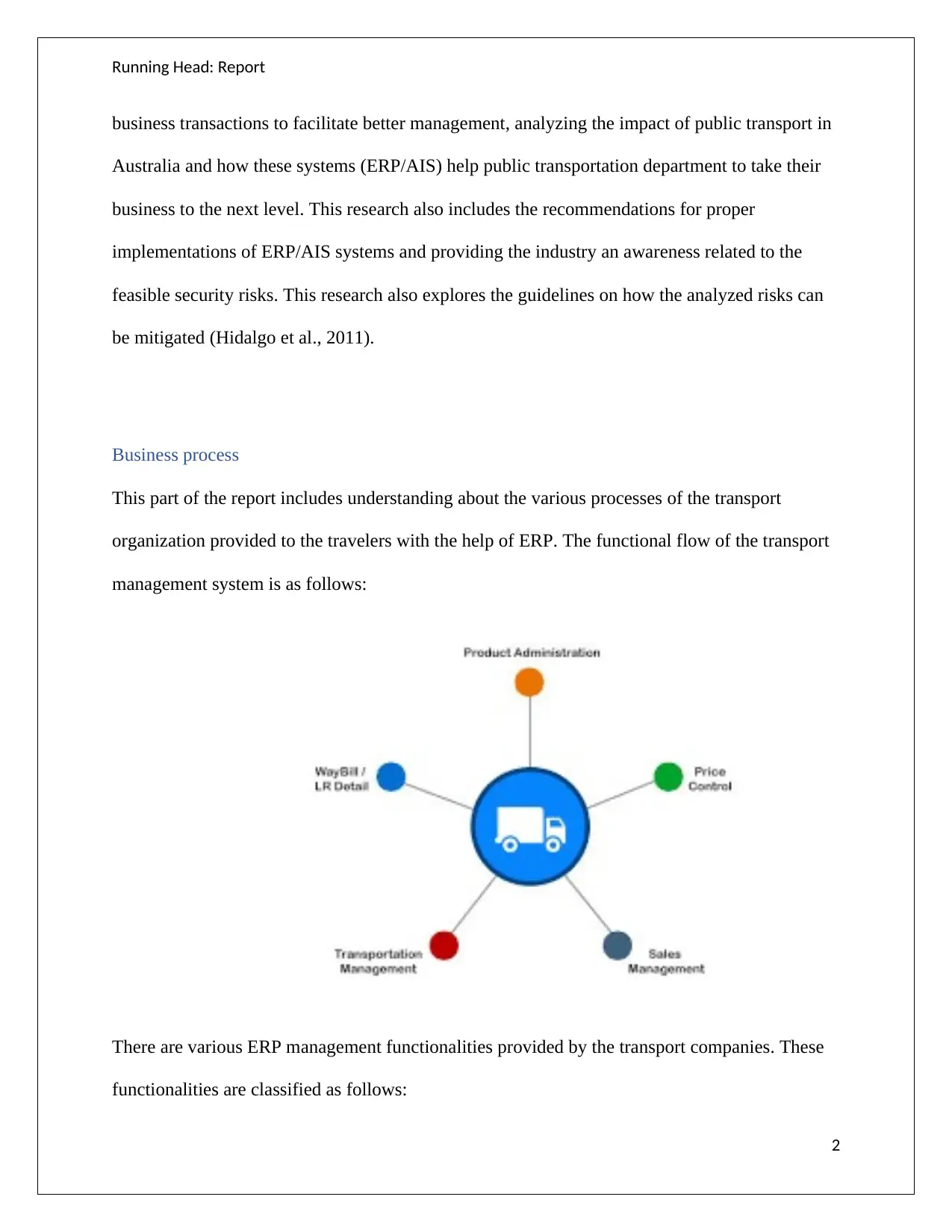
Running Head: Report
business transactions to facilitate better management, analyzing the impact of public transport in
Australia and how these systems (ERP/AIS) help public transportation department to take their
business to the next level. This research also includes the recommendations for proper
implementations of ERP/AIS systems and providing the industry an awareness related to the
feasible security risks. This research also explores the guidelines on how the analyzed risks can
be mitigated (Hidalgo et al., 2011).
Business process
This part of the report includes understanding about the various processes of the transport
organization provided to the travelers with the help of ERP. The functional flow of the transport
management system is as follows:
There are various ERP management functionalities provided by the transport companies. These
functionalities are classified as follows:
2
business transactions to facilitate better management, analyzing the impact of public transport in
Australia and how these systems (ERP/AIS) help public transportation department to take their
business to the next level. This research also includes the recommendations for proper
implementations of ERP/AIS systems and providing the industry an awareness related to the
feasible security risks. This research also explores the guidelines on how the analyzed risks can
be mitigated (Hidalgo et al., 2011).
Business process
This part of the report includes understanding about the various processes of the transport
organization provided to the travelers with the help of ERP. The functional flow of the transport
management system is as follows:
There are various ERP management functionalities provided by the transport companies. These
functionalities are classified as follows:
2
⊘ This is a preview!⊘
Do you want full access?
Subscribe today to unlock all pages.

Trusted by 1+ million students worldwide

Running Head: Report
Mode Support: ERP transportation system plays a major role in providing various
options or mode of transport and saving the financial cost (Starr, 2013). This system
helps in providing different travel packages provided by different modes of transport such
as rail, bus, flight, taxi, etc. and help the users travel long term in less expenses.
Finance Functionality: This includes the exchange of money between the bus owners or
transport organizations and the users. This involves the billing of transportation, invoices,
freight calculations etc.
Operations Management: This management handles all types of rates, tariffs, capacity
of the mode selected, and asset management (CIMA, 2016).
Strategic Management: This part of the management defines the design of the network,
decisions related to the sources, administration and overall flow of the process.
Calculation of Key Performance Indicators: This functionality manages to calculate
the exact values of the ERP metrics like those of calculating the percentage difference in
pick up, drop, cost per distance etc.
Route Planning: This functionality helps in managing the routes, carriers, drivers etc.
Execution Monitoring: This functionality of transport management system helps in
retrieving the real-time updates to the location and progress. This functionality also helps
in communicating with the drivers in real-time (Aberdeen Group, 2013).
Business requirements
The public transportation company provide services to the customers that enable them to travel
from one place to another. The transport companies provide services to the travelers that enable
them to track their booked mode of transport online, make the queries and payments, etc. Thus,
3
Mode Support: ERP transportation system plays a major role in providing various
options or mode of transport and saving the financial cost (Starr, 2013). This system
helps in providing different travel packages provided by different modes of transport such
as rail, bus, flight, taxi, etc. and help the users travel long term in less expenses.
Finance Functionality: This includes the exchange of money between the bus owners or
transport organizations and the users. This involves the billing of transportation, invoices,
freight calculations etc.
Operations Management: This management handles all types of rates, tariffs, capacity
of the mode selected, and asset management (CIMA, 2016).
Strategic Management: This part of the management defines the design of the network,
decisions related to the sources, administration and overall flow of the process.
Calculation of Key Performance Indicators: This functionality manages to calculate
the exact values of the ERP metrics like those of calculating the percentage difference in
pick up, drop, cost per distance etc.
Route Planning: This functionality helps in managing the routes, carriers, drivers etc.
Execution Monitoring: This functionality of transport management system helps in
retrieving the real-time updates to the location and progress. This functionality also helps
in communicating with the drivers in real-time (Aberdeen Group, 2013).
Business requirements
The public transportation company provide services to the customers that enable them to travel
from one place to another. The transport companies provide services to the travelers that enable
them to track their booked mode of transport online, make the queries and payments, etc. Thus,
3
Paraphrase This Document
Need a fresh take? Get an instant paraphrase of this document with our AI Paraphraser
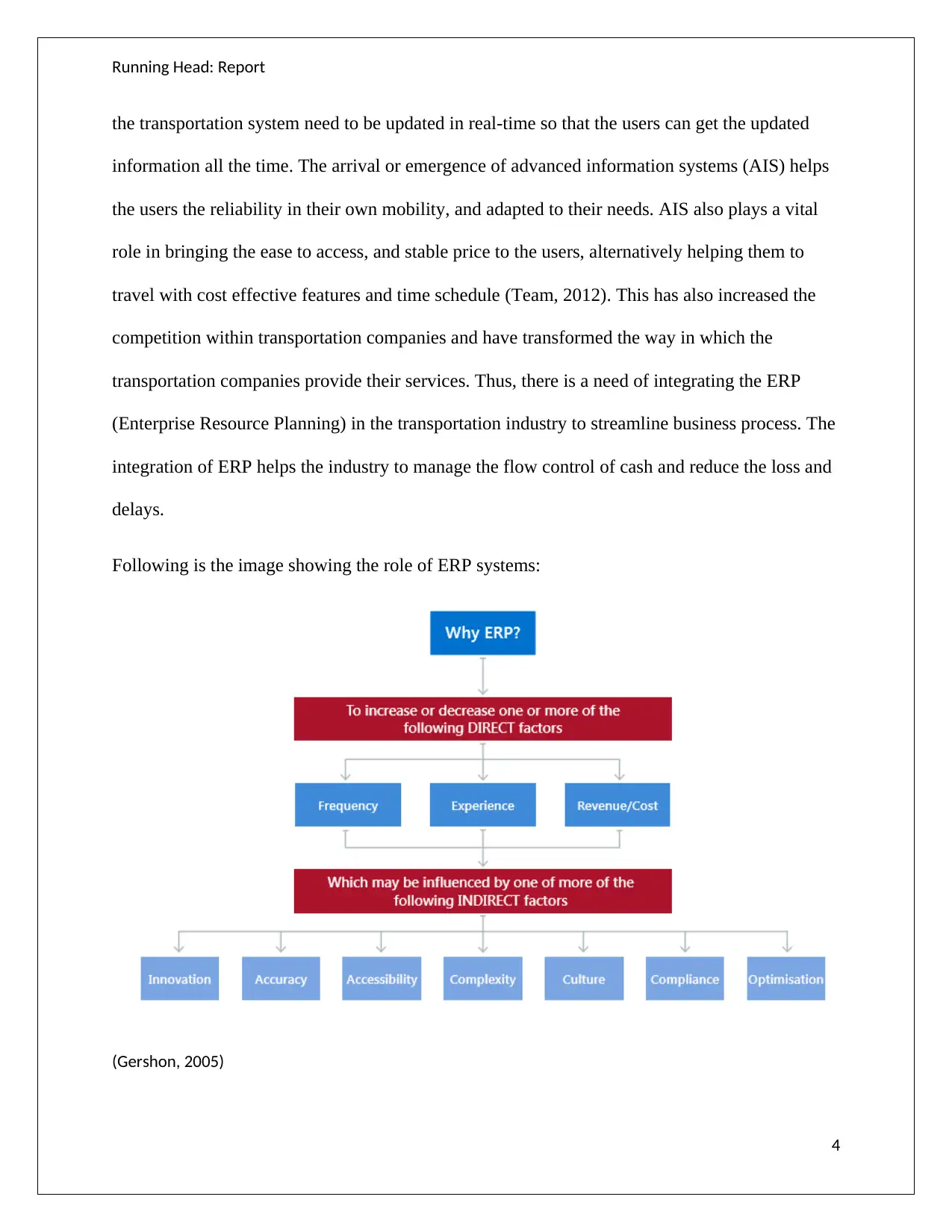
Running Head: Report
the transportation system need to be updated in real-time so that the users can get the updated
information all the time. The arrival or emergence of advanced information systems (AIS) helps
the users the reliability in their own mobility, and adapted to their needs. AIS also plays a vital
role in bringing the ease to access, and stable price to the users, alternatively helping them to
travel with cost effective features and time schedule (Team, 2012). This has also increased the
competition within transportation companies and have transformed the way in which the
transportation companies provide their services. Thus, there is a need of integrating the ERP
(Enterprise Resource Planning) in the transportation industry to streamline business process. The
integration of ERP helps the industry to manage the flow control of cash and reduce the loss and
delays.
Following is the image showing the role of ERP systems:
(Gershon, 2005)
4
the transportation system need to be updated in real-time so that the users can get the updated
information all the time. The arrival or emergence of advanced information systems (AIS) helps
the users the reliability in their own mobility, and adapted to their needs. AIS also plays a vital
role in bringing the ease to access, and stable price to the users, alternatively helping them to
travel with cost effective features and time schedule (Team, 2012). This has also increased the
competition within transportation companies and have transformed the way in which the
transportation companies provide their services. Thus, there is a need of integrating the ERP
(Enterprise Resource Planning) in the transportation industry to streamline business process. The
integration of ERP helps the industry to manage the flow control of cash and reduce the loss and
delays.
Following is the image showing the role of ERP systems:
(Gershon, 2005)
4
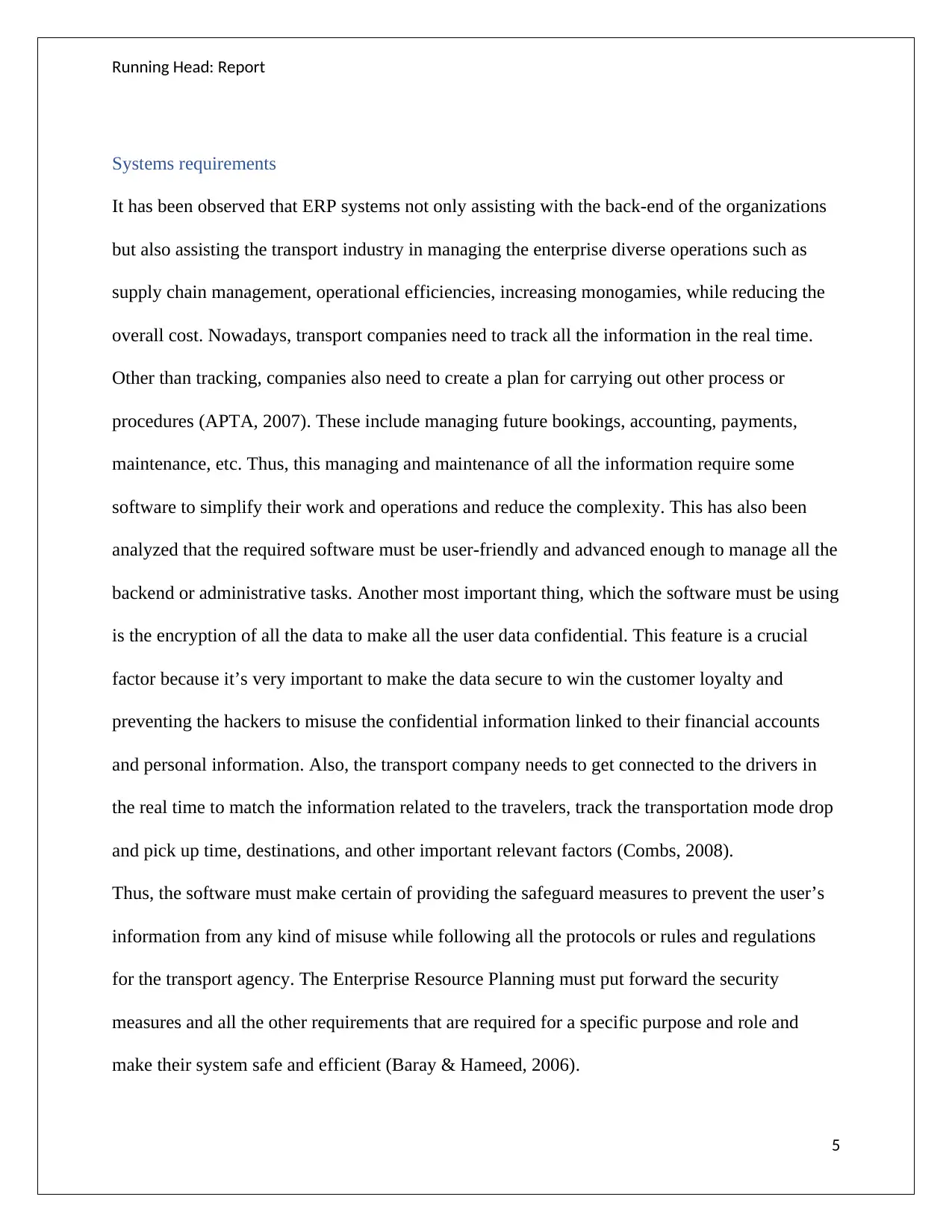
Running Head: Report
Systems requirements
It has been observed that ERP systems not only assisting with the back-end of the organizations
but also assisting the transport industry in managing the enterprise diverse operations such as
supply chain management, operational efficiencies, increasing monogamies, while reducing the
overall cost. Nowadays, transport companies need to track all the information in the real time.
Other than tracking, companies also need to create a plan for carrying out other process or
procedures (APTA, 2007). These include managing future bookings, accounting, payments,
maintenance, etc. Thus, this managing and maintenance of all the information require some
software to simplify their work and operations and reduce the complexity. This has also been
analyzed that the required software must be user-friendly and advanced enough to manage all the
backend or administrative tasks. Another most important thing, which the software must be using
is the encryption of all the data to make all the user data confidential. This feature is a crucial
factor because it’s very important to make the data secure to win the customer loyalty and
preventing the hackers to misuse the confidential information linked to their financial accounts
and personal information. Also, the transport company needs to get connected to the drivers in
the real time to match the information related to the travelers, track the transportation mode drop
and pick up time, destinations, and other important relevant factors (Combs, 2008).
Thus, the software must make certain of providing the safeguard measures to prevent the user’s
information from any kind of misuse while following all the protocols or rules and regulations
for the transport agency. The Enterprise Resource Planning must put forward the security
measures and all the other requirements that are required for a specific purpose and role and
make their system safe and efficient (Baray & Hameed, 2006).
5
Systems requirements
It has been observed that ERP systems not only assisting with the back-end of the organizations
but also assisting the transport industry in managing the enterprise diverse operations such as
supply chain management, operational efficiencies, increasing monogamies, while reducing the
overall cost. Nowadays, transport companies need to track all the information in the real time.
Other than tracking, companies also need to create a plan for carrying out other process or
procedures (APTA, 2007). These include managing future bookings, accounting, payments,
maintenance, etc. Thus, this managing and maintenance of all the information require some
software to simplify their work and operations and reduce the complexity. This has also been
analyzed that the required software must be user-friendly and advanced enough to manage all the
backend or administrative tasks. Another most important thing, which the software must be using
is the encryption of all the data to make all the user data confidential. This feature is a crucial
factor because it’s very important to make the data secure to win the customer loyalty and
preventing the hackers to misuse the confidential information linked to their financial accounts
and personal information. Also, the transport company needs to get connected to the drivers in
the real time to match the information related to the travelers, track the transportation mode drop
and pick up time, destinations, and other important relevant factors (Combs, 2008).
Thus, the software must make certain of providing the safeguard measures to prevent the user’s
information from any kind of misuse while following all the protocols or rules and regulations
for the transport agency. The Enterprise Resource Planning must put forward the security
measures and all the other requirements that are required for a specific purpose and role and
make their system safe and efficient (Baray & Hameed, 2006).
5
⊘ This is a preview!⊘
Do you want full access?
Subscribe today to unlock all pages.

Trusted by 1+ million students worldwide

Running Head: Report
6
6
Paraphrase This Document
Need a fresh take? Get an instant paraphrase of this document with our AI Paraphraser
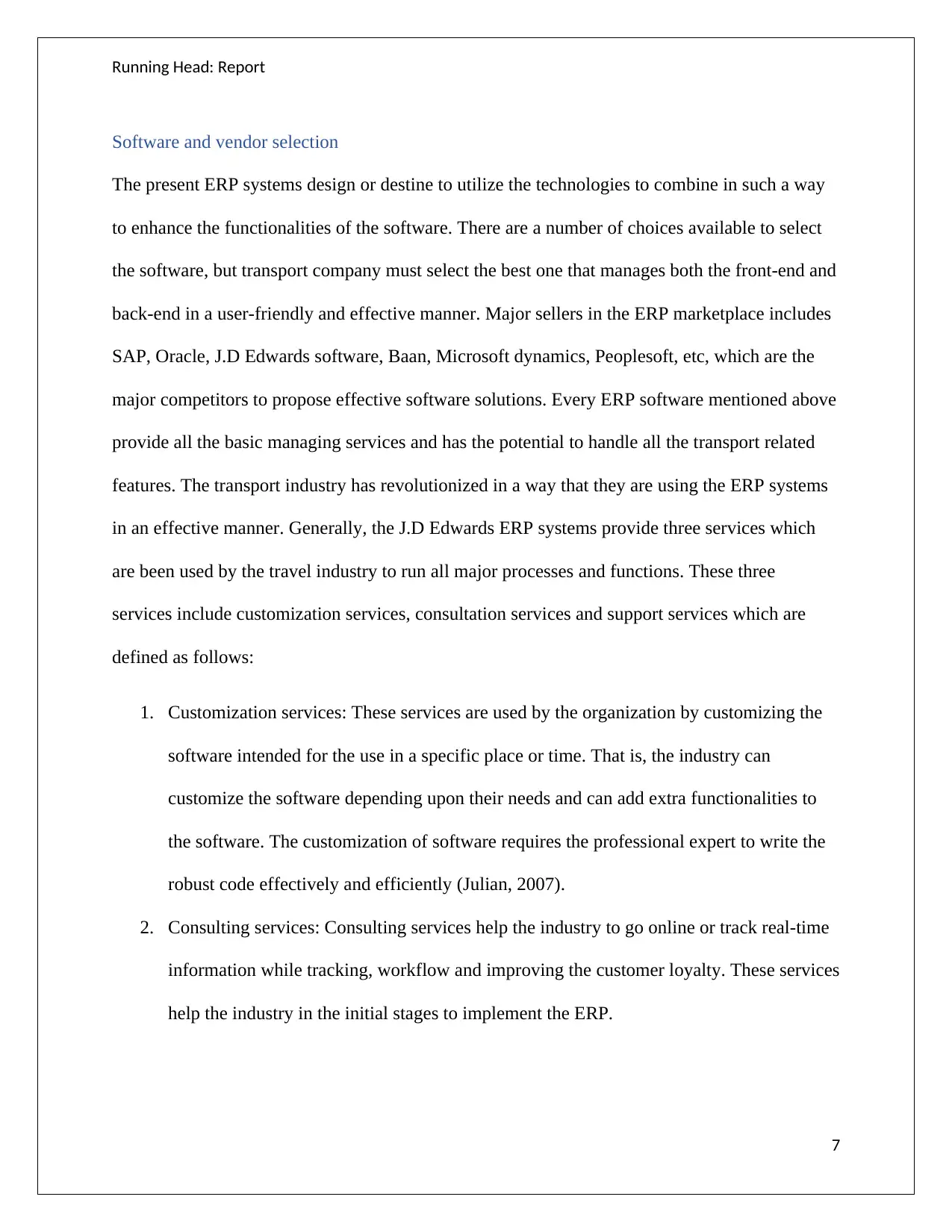
Running Head: Report
Software and vendor selection
The present ERP systems design or destine to utilize the technologies to combine in such a way
to enhance the functionalities of the software. There are a number of choices available to select
the software, but transport company must select the best one that manages both the front-end and
back-end in a user-friendly and effective manner. Major sellers in the ERP marketplace includes
SAP, Oracle, J.D Edwards software, Baan, Microsoft dynamics, Peoplesoft, etc, which are the
major competitors to propose effective software solutions. Every ERP software mentioned above
provide all the basic managing services and has the potential to handle all the transport related
features. The transport industry has revolutionized in a way that they are using the ERP systems
in an effective manner. Generally, the J.D Edwards ERP systems provide three services which
are been used by the travel industry to run all major processes and functions. These three
services include customization services, consultation services and support services which are
defined as follows:
1. Customization services: These services are used by the organization by customizing the
software intended for the use in a specific place or time. That is, the industry can
customize the software depending upon their needs and can add extra functionalities to
the software. The customization of software requires the professional expert to write the
robust code effectively and efficiently (Julian, 2007).
2. Consulting services: Consulting services help the industry to go online or track real-time
information while tracking, workflow and improving the customer loyalty. These services
help the industry in the initial stages to implement the ERP.
7
Software and vendor selection
The present ERP systems design or destine to utilize the technologies to combine in such a way
to enhance the functionalities of the software. There are a number of choices available to select
the software, but transport company must select the best one that manages both the front-end and
back-end in a user-friendly and effective manner. Major sellers in the ERP marketplace includes
SAP, Oracle, J.D Edwards software, Baan, Microsoft dynamics, Peoplesoft, etc, which are the
major competitors to propose effective software solutions. Every ERP software mentioned above
provide all the basic managing services and has the potential to handle all the transport related
features. The transport industry has revolutionized in a way that they are using the ERP systems
in an effective manner. Generally, the J.D Edwards ERP systems provide three services which
are been used by the travel industry to run all major processes and functions. These three
services include customization services, consultation services and support services which are
defined as follows:
1. Customization services: These services are used by the organization by customizing the
software intended for the use in a specific place or time. That is, the industry can
customize the software depending upon their needs and can add extra functionalities to
the software. The customization of software requires the professional expert to write the
robust code effectively and efficiently (Julian, 2007).
2. Consulting services: Consulting services help the industry to go online or track real-time
information while tracking, workflow and improving the customer loyalty. These services
help the industry in the initial stages to implement the ERP.
7

Running Head: Report
3. Support services: These services help in providing the solutions to troubleshoot the issues
and assistance with various ERP issues, that is, these services provide both the
maintenance as well as support (Jatin, 2013).
Ways to utilize technology for business efficiency
In this competitive world, it is very important to use the best tools and technologies to manage
the functions of the industry. As the travel industry requires the regular updates and the real-time
tracking, it is very important to choose the best software providing the best features and
functionalities. One of the advantageous software is the ERP software, which can be easily
customized so as to reduce the labor hours of the industry, thereby decreasing the operational
costs (Goldsmith et al., 2006).
Following are the ways in which the ERP software can be utilized to get more benefits from it:
Integrated Information: To perform the various functions at the same time and managing
all the functions, ERP system provides a one stop service for all. That is, there is no need
to buy a new software or manage other software to handle multiple tasks. ERP provides
the information in an integrated manner which can be retrieved any time.
Increased efficiency in processes: The data and information can be collected in a more
effective and accurate manner which eliminates or put an end to processes which require
manual efforts. The information can be collected from the software in a fraction of
seconds, thereby helping the travel industry in numerous ways.
Effective management: The management required various control systems to examine the
present promotions, offers, and customer loyalty strategies being implemented by the
8
3. Support services: These services help in providing the solutions to troubleshoot the issues
and assistance with various ERP issues, that is, these services provide both the
maintenance as well as support (Jatin, 2013).
Ways to utilize technology for business efficiency
In this competitive world, it is very important to use the best tools and technologies to manage
the functions of the industry. As the travel industry requires the regular updates and the real-time
tracking, it is very important to choose the best software providing the best features and
functionalities. One of the advantageous software is the ERP software, which can be easily
customized so as to reduce the labor hours of the industry, thereby decreasing the operational
costs (Goldsmith et al., 2006).
Following are the ways in which the ERP software can be utilized to get more benefits from it:
Integrated Information: To perform the various functions at the same time and managing
all the functions, ERP system provides a one stop service for all. That is, there is no need
to buy a new software or manage other software to handle multiple tasks. ERP provides
the information in an integrated manner which can be retrieved any time.
Increased efficiency in processes: The data and information can be collected in a more
effective and accurate manner which eliminates or put an end to processes which require
manual efforts. The information can be collected from the software in a fraction of
seconds, thereby helping the travel industry in numerous ways.
Effective management: The management required various control systems to examine the
present promotions, offers, and customer loyalty strategies being implemented by the
8
⊘ This is a preview!⊘
Do you want full access?
Subscribe today to unlock all pages.

Trusted by 1+ million students worldwide
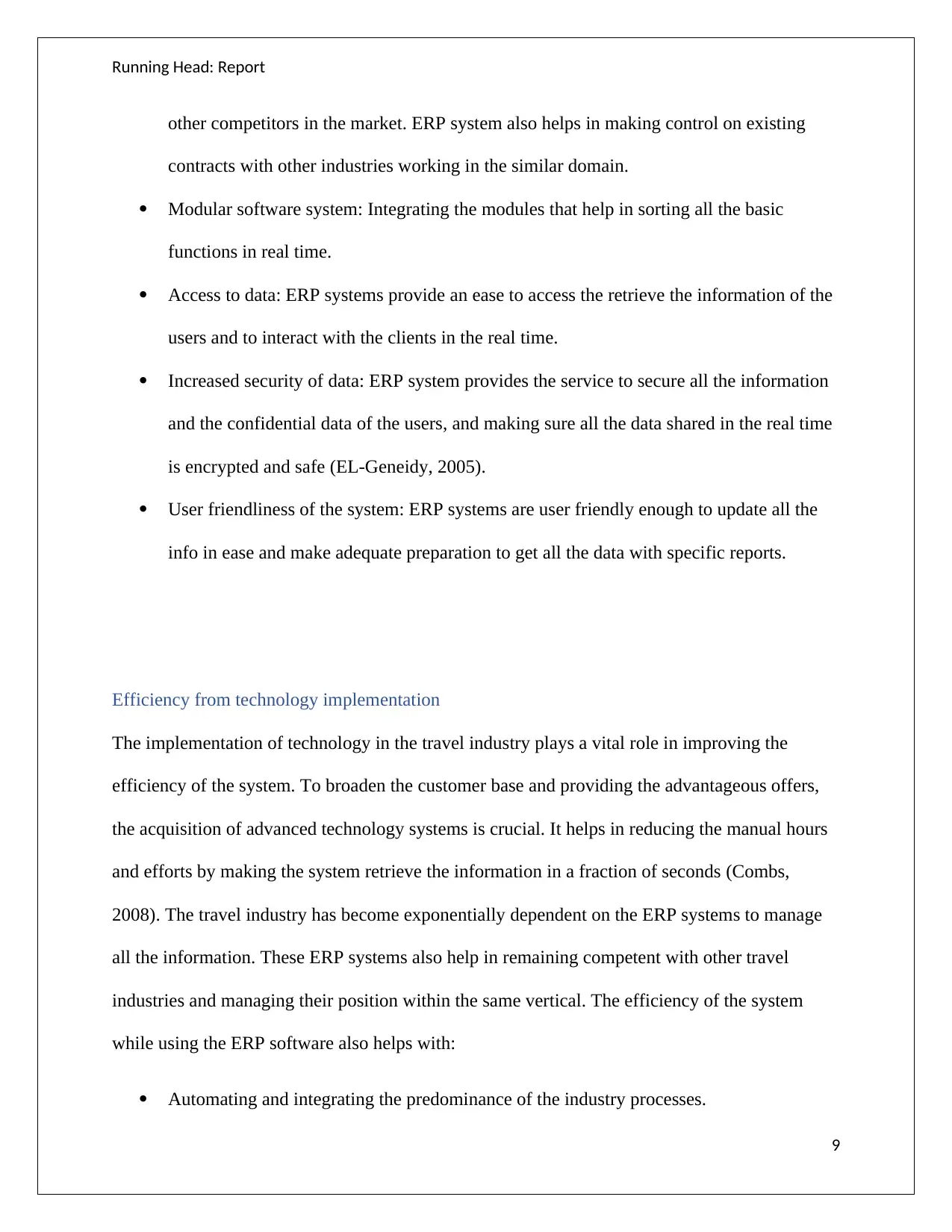
Running Head: Report
other competitors in the market. ERP system also helps in making control on existing
contracts with other industries working in the similar domain.
Modular software system: Integrating the modules that help in sorting all the basic
functions in real time.
Access to data: ERP systems provide an ease to access the retrieve the information of the
users and to interact with the clients in the real time.
Increased security of data: ERP system provides the service to secure all the information
and the confidential data of the users, and making sure all the data shared in the real time
is encrypted and safe (EL-Geneidy, 2005).
User friendliness of the system: ERP systems are user friendly enough to update all the
info in ease and make adequate preparation to get all the data with specific reports.
Efficiency from technology implementation
The implementation of technology in the travel industry plays a vital role in improving the
efficiency of the system. To broaden the customer base and providing the advantageous offers,
the acquisition of advanced technology systems is crucial. It helps in reducing the manual hours
and efforts by making the system retrieve the information in a fraction of seconds (Combs,
2008). The travel industry has become exponentially dependent on the ERP systems to manage
all the information. These ERP systems also help in remaining competent with other travel
industries and managing their position within the same vertical. The efficiency of the system
while using the ERP software also helps with:
Automating and integrating the predominance of the industry processes.
9
other competitors in the market. ERP system also helps in making control on existing
contracts with other industries working in the similar domain.
Modular software system: Integrating the modules that help in sorting all the basic
functions in real time.
Access to data: ERP systems provide an ease to access the retrieve the information of the
users and to interact with the clients in the real time.
Increased security of data: ERP system provides the service to secure all the information
and the confidential data of the users, and making sure all the data shared in the real time
is encrypted and safe (EL-Geneidy, 2005).
User friendliness of the system: ERP systems are user friendly enough to update all the
info in ease and make adequate preparation to get all the data with specific reports.
Efficiency from technology implementation
The implementation of technology in the travel industry plays a vital role in improving the
efficiency of the system. To broaden the customer base and providing the advantageous offers,
the acquisition of advanced technology systems is crucial. It helps in reducing the manual hours
and efforts by making the system retrieve the information in a fraction of seconds (Combs,
2008). The travel industry has become exponentially dependent on the ERP systems to manage
all the information. These ERP systems also help in remaining competent with other travel
industries and managing their position within the same vertical. The efficiency of the system
while using the ERP software also helps with:
Automating and integrating the predominance of the industry processes.
9
Paraphrase This Document
Need a fresh take? Get an instant paraphrase of this document with our AI Paraphraser
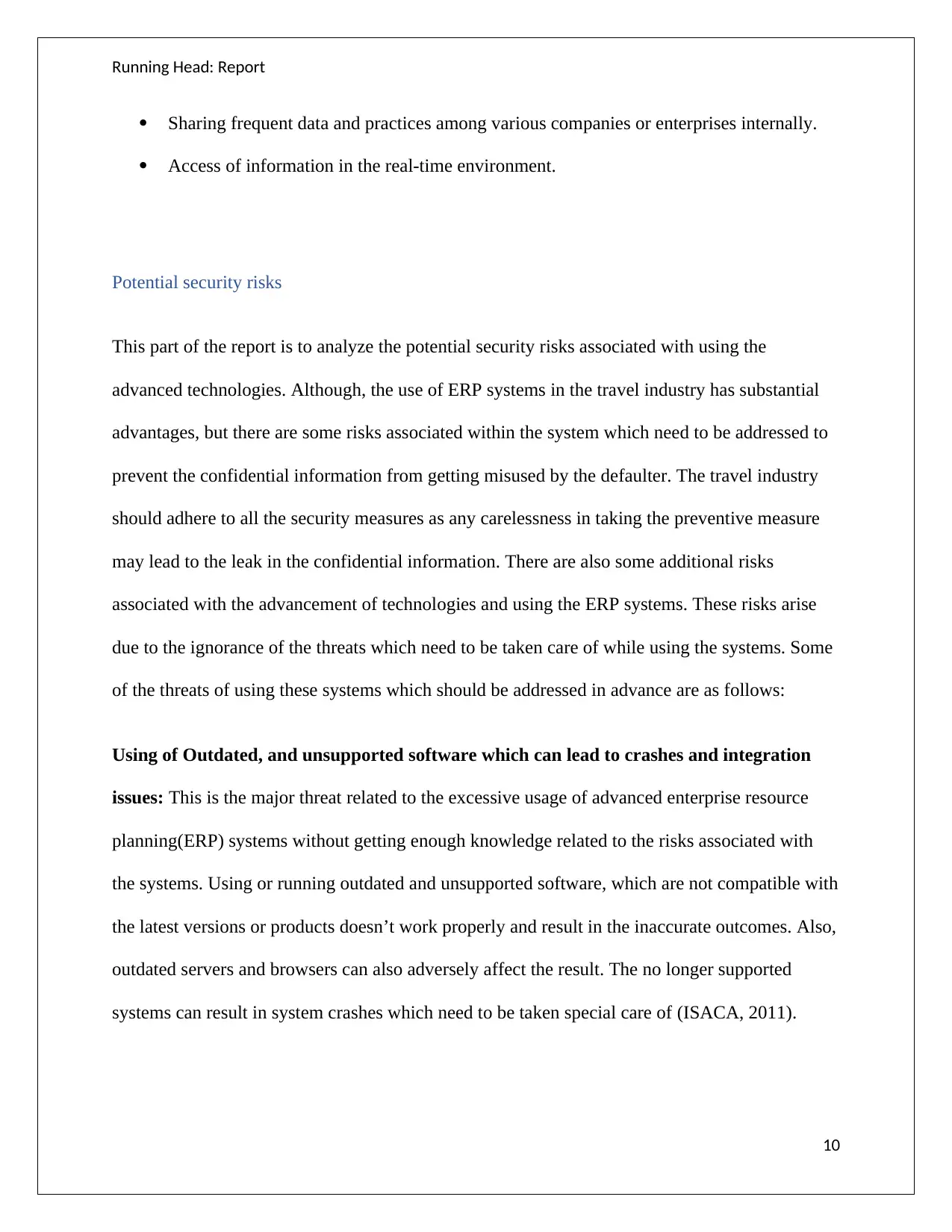
Running Head: Report
Sharing frequent data and practices among various companies or enterprises internally.
Access of information in the real-time environment.
Potential security risks
This part of the report is to analyze the potential security risks associated with using the
advanced technologies. Although, the use of ERP systems in the travel industry has substantial
advantages, but there are some risks associated within the system which need to be addressed to
prevent the confidential information from getting misused by the defaulter. The travel industry
should adhere to all the security measures as any carelessness in taking the preventive measure
may lead to the leak in the confidential information. There are also some additional risks
associated with the advancement of technologies and using the ERP systems. These risks arise
due to the ignorance of the threats which need to be taken care of while using the systems. Some
of the threats of using these systems which should be addressed in advance are as follows:
Using of Outdated, and unsupported software which can lead to crashes and integration
issues: This is the major threat related to the excessive usage of advanced enterprise resource
planning(ERP) systems without getting enough knowledge related to the risks associated with
the systems. Using or running outdated and unsupported software, which are not compatible with
the latest versions or products doesn’t work properly and result in the inaccurate outcomes. Also,
outdated servers and browsers can also adversely affect the result. The no longer supported
systems can result in system crashes which need to be taken special care of (ISACA, 2011).
10
Sharing frequent data and practices among various companies or enterprises internally.
Access of information in the real-time environment.
Potential security risks
This part of the report is to analyze the potential security risks associated with using the
advanced technologies. Although, the use of ERP systems in the travel industry has substantial
advantages, but there are some risks associated within the system which need to be addressed to
prevent the confidential information from getting misused by the defaulter. The travel industry
should adhere to all the security measures as any carelessness in taking the preventive measure
may lead to the leak in the confidential information. There are also some additional risks
associated with the advancement of technologies and using the ERP systems. These risks arise
due to the ignorance of the threats which need to be taken care of while using the systems. Some
of the threats of using these systems which should be addressed in advance are as follows:
Using of Outdated, and unsupported software which can lead to crashes and integration
issues: This is the major threat related to the excessive usage of advanced enterprise resource
planning(ERP) systems without getting enough knowledge related to the risks associated with
the systems. Using or running outdated and unsupported software, which are not compatible with
the latest versions or products doesn’t work properly and result in the inaccurate outcomes. Also,
outdated servers and browsers can also adversely affect the result. The no longer supported
systems can result in system crashes which need to be taken special care of (ISACA, 2011).
10
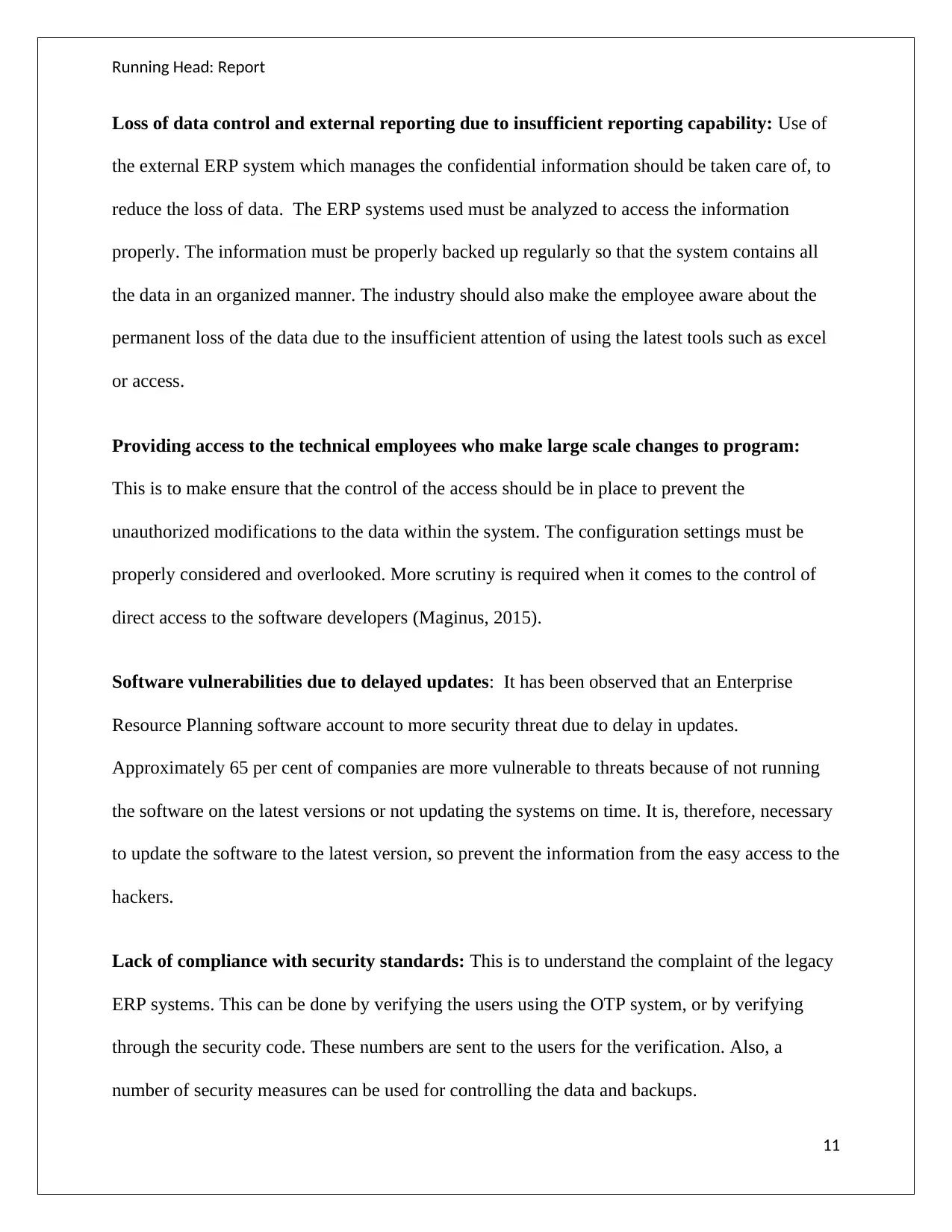
Running Head: Report
Loss of data control and external reporting due to insufficient reporting capability: Use of
the external ERP system which manages the confidential information should be taken care of, to
reduce the loss of data. The ERP systems used must be analyzed to access the information
properly. The information must be properly backed up regularly so that the system contains all
the data in an organized manner. The industry should also make the employee aware about the
permanent loss of the data due to the insufficient attention of using the latest tools such as excel
or access.
Providing access to the technical employees who make large scale changes to program:
This is to make ensure that the control of the access should be in place to prevent the
unauthorized modifications to the data within the system. The configuration settings must be
properly considered and overlooked. More scrutiny is required when it comes to the control of
direct access to the software developers (Maginus, 2015).
Software vulnerabilities due to delayed updates: It has been observed that an Enterprise
Resource Planning software account to more security threat due to delay in updates.
Approximately 65 per cent of companies are more vulnerable to threats because of not running
the software on the latest versions or not updating the systems on time. It is, therefore, necessary
to update the software to the latest version, so prevent the information from the easy access to the
hackers.
Lack of compliance with security standards: This is to understand the complaint of the legacy
ERP systems. This can be done by verifying the users using the OTP system, or by verifying
through the security code. These numbers are sent to the users for the verification. Also, a
number of security measures can be used for controlling the data and backups.
11
Loss of data control and external reporting due to insufficient reporting capability: Use of
the external ERP system which manages the confidential information should be taken care of, to
reduce the loss of data. The ERP systems used must be analyzed to access the information
properly. The information must be properly backed up regularly so that the system contains all
the data in an organized manner. The industry should also make the employee aware about the
permanent loss of the data due to the insufficient attention of using the latest tools such as excel
or access.
Providing access to the technical employees who make large scale changes to program:
This is to make ensure that the control of the access should be in place to prevent the
unauthorized modifications to the data within the system. The configuration settings must be
properly considered and overlooked. More scrutiny is required when it comes to the control of
direct access to the software developers (Maginus, 2015).
Software vulnerabilities due to delayed updates: It has been observed that an Enterprise
Resource Planning software account to more security threat due to delay in updates.
Approximately 65 per cent of companies are more vulnerable to threats because of not running
the software on the latest versions or not updating the systems on time. It is, therefore, necessary
to update the software to the latest version, so prevent the information from the easy access to the
hackers.
Lack of compliance with security standards: This is to understand the complaint of the legacy
ERP systems. This can be done by verifying the users using the OTP system, or by verifying
through the security code. These numbers are sent to the users for the verification. Also, a
number of security measures can be used for controlling the data and backups.
11
⊘ This is a preview!⊘
Do you want full access?
Subscribe today to unlock all pages.

Trusted by 1+ million students worldwide
1 out of 19
Related Documents
Your All-in-One AI-Powered Toolkit for Academic Success.
+13062052269
info@desklib.com
Available 24*7 on WhatsApp / Email
![[object Object]](/_next/static/media/star-bottom.7253800d.svg)
Unlock your academic potential
Copyright © 2020–2025 A2Z Services. All Rights Reserved. Developed and managed by ZUCOL.





